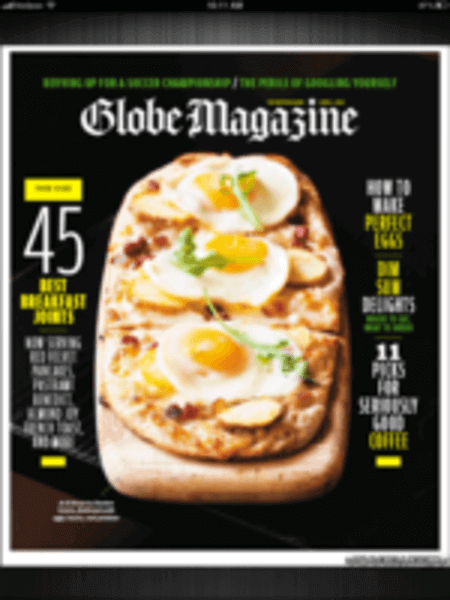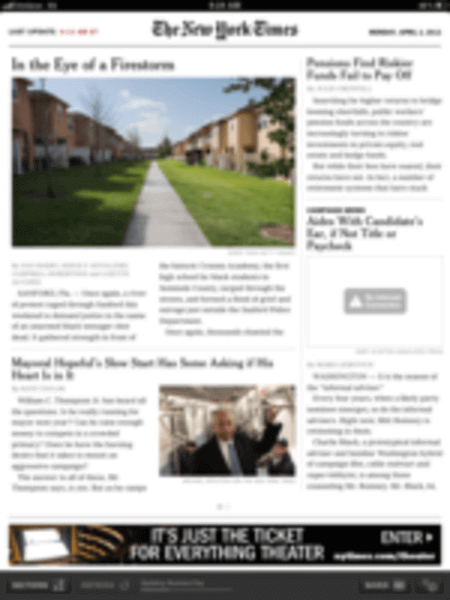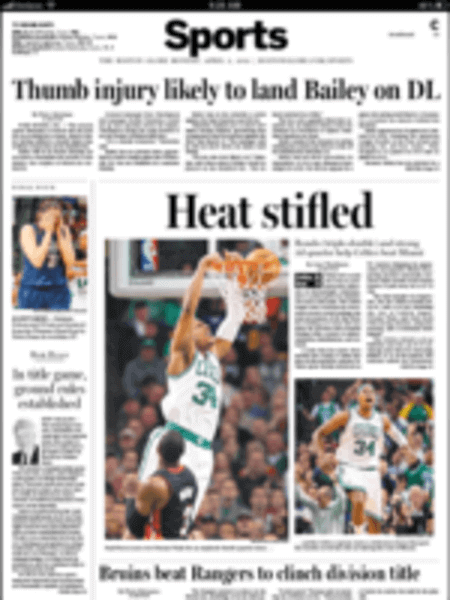It’s a bit of a role reversal at the college newspaper where I am the faculty adviser: I, playing the role of old ink-stained curmudgeon, keep insisting the students need to think about improving their website and developing multimedia reporting skills, while they insist they love putting out a dead-tree product each week.

They especially love designing pages, a pizza-fueled event that is repeated on nine Wednesday nights each semester. “Why?” I all but scream at them. “It’s a skill that isn’t going to matter in another couple of years!”
That’s a tough admission for a lifetime newspaper junkie who still insists that two stacks of dead trees be dumped on my doorstep every Sunday morning. I thought I was older and wiser, and that I was, sadly, right. But after spending the weekend playing around with the Boston Globe’s new iPad app, it turns out I may need to learn a thing or two from the kids.
The Globe is my hometown newspaper, the paper that made me fall in love with print journalism as an 11-year-old when I learned there was a world beyond the comics and sports pages. And, by way of full disclosure, I was able to fulfill a lifelong dream, writing regularly for the paper’s business desk between April 2008 and January 2011. That was when even I, one of the last holdouts, had to concede the future for newspapers wasn’t bright.

The Globe is also owned by The New York Times, which has its own slick iPad app. It looks and feels like a Web page and makes use of stunning video and photos. Sharing articles on Twitter, Facebook and email is easy and, because it is, after all, The New York Times, I just assumed that it would be the standard all papers would live up to.
Don’t Retrain Page Designers Yet
The Globe, however, has gone in a different direction, essentially reproducing print pages in the iPad app. At first glance it looked archaic, like PDFs crammed into a too-small screen. But within seconds, intuition took over, and I quickly saw there was tons of functionality. I could zoom into articles and, once I clicked onto one I wanted to read, the reading interface was more like the eye-friendly Web page The Times delivers.
I can share articles on social media as easily as I can on The Times iPad app, but the Globe offers an added layer of interaction: a thumbs up, thumbs down button where I can register whether I agree or disagree with the article. I’m not sure how far the interaction will go, but it seems like a step in the right direction toward engaging readers.
Online, the Globe moved premium content behind a paywall last year. Casual readers can still access lots of free content (and lots of teasers for paid content) at boston.com, but the premium stuff lies behind the paywall at BostonGlobe.com (as a Sunday print subscriber, I get access to the premium site and the iPad app, even though the weekly Sunday print subscription is cheaper than the weekly online rate).

Having worked with many of the photographers who were learning how to shoot videos, I hope a lot of that video content makes it onto the iPad app. I didn’t see any in the seven issues I read during the weekend, but it makes sense that it will end up on the iPad, and if I did have a complaint about the new iPad app, it would be that it still feels a little too much like a newspaper and not the multimedia-storytelling platform that it is.
Which is Better?
Here’s my big problem: I love both apps. They both offer something unique in terms of reader experience. Most importantly, they deliver news in a way that is usable, which hasn’t always been the case with their online cousins.
But – and this may be my antiquated bias to ink showing through – if I had to choose, I give the nod to the Globe. The reason is simple: I feel smarter after reading a newspaper cover to cover, as it exposes me to all sorts of articles I may not have read if I hadn’t scanned the headline.
Eli Pariser’s The Filter Bubble has its fair share of critics, but there’s something to be said about the Internet only exposing us to news and content we’re already interested in, as opposed to content and news we should be interested in.
The Globe iPad app, which lets me sweep through the pages like a traditional newspaper, does a better job of giving me a balanced news diet – without the hassle of getting ink stains on my finger tips.










